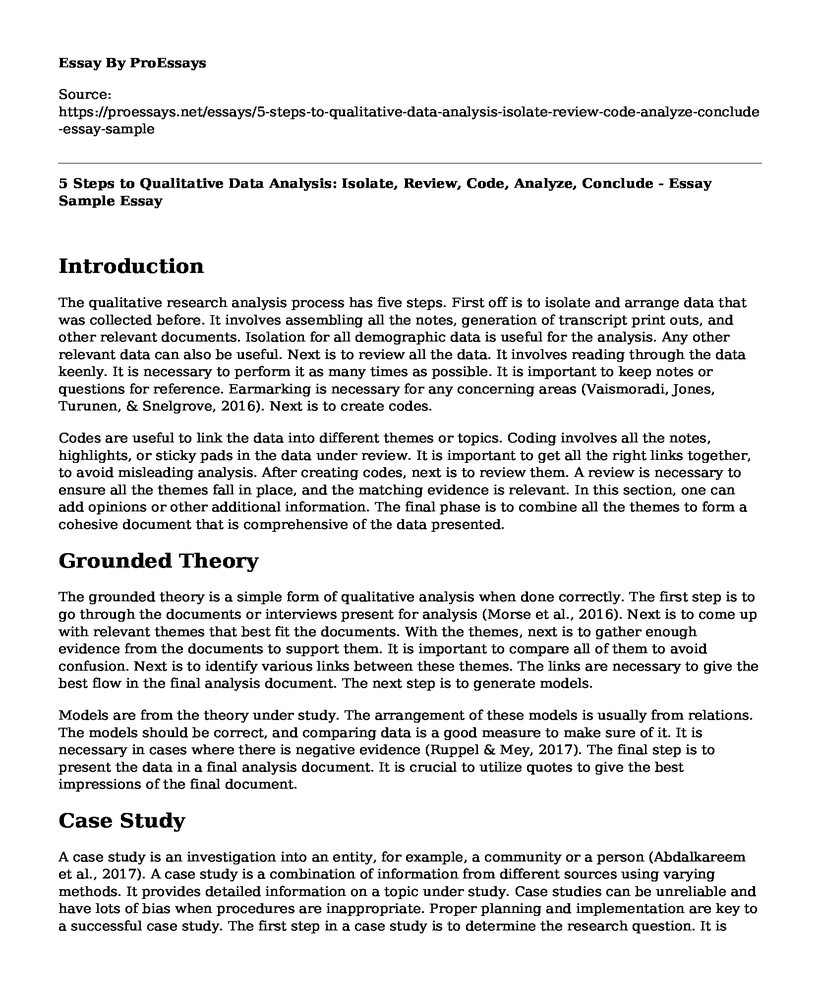Introduction
The qualitative research analysis process has five steps. First off is to isolate and arrange data that was collected before. It involves assembling all the notes, generation of transcript print outs, and other relevant documents. Isolation for all demographic data is useful for the analysis. Any other relevant data can also be useful. Next is to review all the data. It involves reading through the data keenly. It is necessary to perform it as many times as possible. It is important to keep notes or questions for reference. Earmarking is necessary for any concerning areas (Vaismoradi, Jones, Turunen, & Snelgrove, 2016). Next is to create codes.
Codes are useful to link the data into different themes or topics. Coding involves all the notes, highlights, or sticky pads in the data under review. It is important to get all the right links together, to avoid misleading analysis. After creating codes, next is to review them. A review is necessary to ensure all the themes fall in place, and the matching evidence is relevant. In this section, one can add opinions or other additional information. The final phase is to combine all the themes to form a cohesive document that is comprehensive of the data presented.
Grounded Theory
The grounded theory is a simple form of qualitative analysis when done correctly. The first step is to go through the documents or interviews present for analysis (Morse et al., 2016). Next is to come up with relevant themes that best fit the documents. With the themes, next is to gather enough evidence from the documents to support them. It is important to compare all of them to avoid confusion. Next is to identify various links between these themes. The links are necessary to give the best flow in the final analysis document. The next step is to generate models.
Models are from the theory under study. The arrangement of these models is usually from relations. The models should be correct, and comparing data is a good measure to make sure of it. It is necessary in cases where there is negative evidence (Ruppel & Mey, 2017). The final step is to present the data in a final analysis document. It is crucial to utilize quotes to give the best impressions of the final document.
Case Study
A case study is an investigation into an entity, for example, a community or a person (Abdalkareem et al., 2017). A case study is a combination of information from different sources using varying methods. It provides detailed information on a topic under study. Case studies can be unreliable and have lots of bias when procedures are inappropriate. Proper planning and implementation are key to a successful case study. The first step in a case study is to determine the research question. It is normally an open-ended question. It is important to understand and interpret it well before continuing. Next is to arrange cases in order of study.
It involves identifying methods of gathering data. It is also important to identify the techniques on how to analyze data. It is best to get as many sources as possible for the study. The study should be as comprehensive as possible to get the best out of the cases. Also, data analysis methods should vary to get information from different angles (Akkermans & Van Oorschot, 2017). Next is to identify methods for data collection. After, it is collecting information from the cases. After collection of data is analyzed. Analysis of data gives a platform to come up with a report.
References
Abdalkareem, R., Nourry, O., Wehaibi, S., Mujahid, S., & Shihab, E. (2017). Why do developers use trivial packages? an empirical case study on npm. Proceedings of the 2017 11th Joint Meeting on Foundations of Software Engineering - ESEC/FSE 2017. https://doi.org/10.1145/3106237.3106267
Akkermans, H. A., & Van Oorschot, K. E. (2017). Relevance assumed: A case study of balanced scorecard development using system dynamics. System Dynamics, 107-132. https://doi.org/10.1057/978-1-349-95257-1_4References
Morse, J. M., Stern, P. N., Phyllis Noerager Stern; DNS; Faan; Nap, Corbin, J., Bowers, B., Charmaz, K., & Clarke, A. E. (2016). Developing Grounded Theory: The Second Generation. London, England: Routledge.
Ruppel, P. S., & Mey, G. (2017). Grounded Theory Methodology. Oxford Research Encyclopedia of Communication. doi:10.1093/acrefore/9780190228613.013.522
Vaismoradi, M., Jones, J., Turunen, H., & Snelgrove, S. (2016). Theme development in qualitative content analysis and thematic analysis. Journal of Nursing Education and Practice, 6(5). doi:10.5430/jnep.v6n5p100
Cite this page
5 Steps to Qualitative Data Analysis: Isolate, Review, Code, Analyze, Conclude - Essay Sample. (2023, Apr 12). Retrieved from https://proessays.net/essays/5-steps-to-qualitative-data-analysis-isolate-review-code-analyze-conclude-essay-sample
If you are the original author of this essay and no longer wish to have it published on the ProEssays website, please click below to request its removal:
- Data Collection and Analysis Plan Paper Example
- High Employee Turnover in the Automotive Industry Paper Example
- Apple SWOT Analysis Paper Example
- Essay Example on Root Cause Analysis of Sentinel Events in Healthcare
- Analysis Essay on Emerging Org: Key Points for Reasonable Comp & Benefits
- Paper Example on The Dependent Variable: Research Studies for Credibility of Education
- Lead Analyst's Challenge: Persuading Stakeholders With Data - Free Report Example







